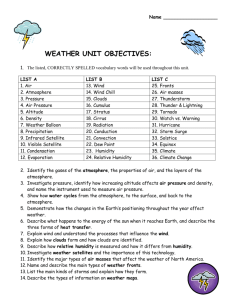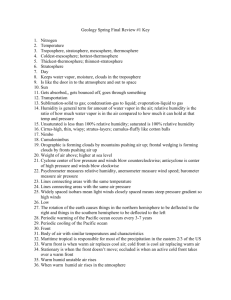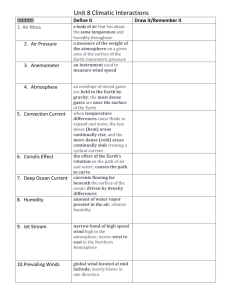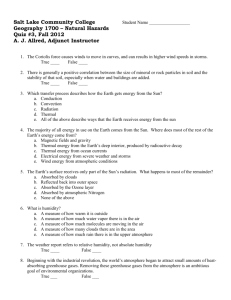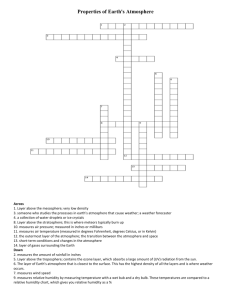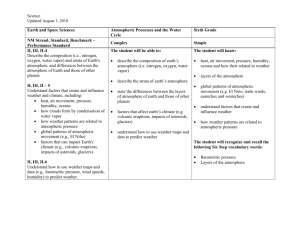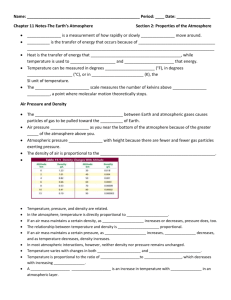Salt Lake Community College Student Name ______ Geography 1700
advertisement
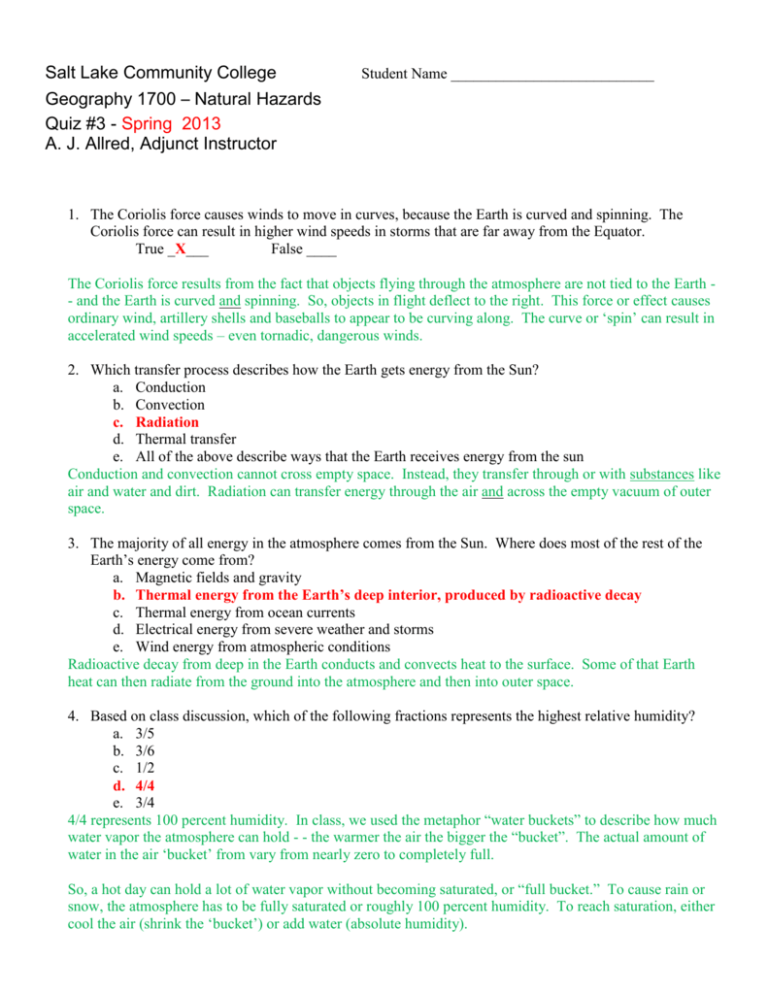
Salt Lake Community College Geography 1700 – Natural Hazards Quiz #3 - Spring 2013 A. J. Allred, Adjunct Instructor Student Name ___________________________ 1. The Coriolis force causes winds to move in curves, because the Earth is curved and spinning. The Coriolis force can result in higher wind speeds in storms that are far away from the Equator. True _X___ False ____ The Coriolis force results from the fact that objects flying through the atmosphere are not tied to the Earth - and the Earth is curved and spinning. So, objects in flight deflect to the right. This force or effect causes ordinary wind, artillery shells and baseballs to appear to be curving along. The curve or ‘spin’ can result in accelerated wind speeds – even tornadic, dangerous winds. 2. Which transfer process describes how the Earth gets energy from the Sun? a. Conduction b. Convection c. Radiation d. Thermal transfer e. All of the above describe ways that the Earth receives energy from the sun Conduction and convection cannot cross empty space. Instead, they transfer through or with substances like air and water and dirt. Radiation can transfer energy through the air and across the empty vacuum of outer space. 3. The majority of all energy in the atmosphere comes from the Sun. Where does most of the rest of the Earth’s energy come from? a. Magnetic fields and gravity b. Thermal energy from the Earth’s deep interior, produced by radioactive decay c. Thermal energy from ocean currents d. Electrical energy from severe weather and storms e. Wind energy from atmospheric conditions Radioactive decay from deep in the Earth conducts and convects heat to the surface. Some of that Earth heat can then radiate from the ground into the atmosphere and then into outer space. 4. Based on class discussion, which of the following fractions represents the highest relative humidity? a. 3/5 b. 3/6 c. 1/2 d. 4/4 e. 3/4 4/4 represents 100 percent humidity. In class, we used the metaphor “water buckets” to describe how much water vapor the atmosphere can hold - - the warmer the air the bigger the “bucket”. The actual amount of water in the air ‘bucket’ from vary from nearly zero to completely full. So, a hot day can hold a lot of water vapor without becoming saturated, or “full bucket.” To cause rain or snow, the atmosphere has to be fully saturated or roughly 100 percent humidity. To reach saturation, either cool the air (shrink the ‘bucket’) or add water (absolute humidity). For the weather report, humidity is always reported “relative” – how close the ‘bucket’ is to being full. 5. The weather report refers to relative humidity, not absolute humidity. True _X___ False ____ See comment above for Question #4. The actual weight or mass of water in the air is not as important as the extent to which the air is nearing saturation. Without saturation, storminess is unlikely. 6. Beginning with the Industrial Revolution, the world’s atmosphere started to receive carbon molecules. Since then, humans have begun to recognize the need to remove greenhouse gases and prevent the atmosphere from contact with carbon. True ____ False _X__ For millions of years, carbon molecules have been a necessary part of the Earth’s atmosphere. Otherwise, the Earth would be much too cold. Since the Industrial Revolution humans have been adding much more carbon to the atmosphere, with the likely result that the Earth is getting warmer because that is what carbon gases do - - they hold heat. 7. Stormy weather in North America typically includes what conditions? a. Rising air b. Relatively high humidity c. Tornadic, cyclonic or counter-clockwise winds d. All of the above e. Only answers a and c above The daily weather report in Utah shows patterns of low and high pressure moving slowly across the United States from west to east. Stormy or wet weather always involves low pressure that lifts air. If air is humidity, then precipitation occurs when the air becomes saturated as it rises (bucket fills up by cooling down). Low pressure systems have winds that turn counter-clockwise. High pressure systems are the opposite – fair skies, descending or stable air, and lower humidity with winds moving clockwise. 8. Violent winds in tornadic storms are associated with: a. Large amounts of latent heat b. Relatively high humidity c. Local differences between cooler/drier air and warmer/wetter air d. Relatively low atmospheric pressure and rising air e. All of the above See notes to #7 above. 9. Stormy weather patterns tend to involve high wind, high humidity, high atmospheric pressure and high rainfall. True ___ False _X__ All of the above are true, except for “high pressure.” Low pressure is associated with rising air and storminess. 10. A hurricane condition would be properly represented by about how much difference in sea level atmospheric pressure between southern Florida and northern Florida? e. 18,000 feet or about 3.5 miles b. 90 mb c. 507 mb d. Any of the above answers can be accurate, because pressure and humidity are relative e. None of the above is a reasonable figure Quickly changing air pressure is normal in the vertical plane. However, horizontally, even a pressure difference of 20mb across a large area can produce strong winds leading to a storm. A 100mb pressure horizontal difference across a large area can represent a strong and dangerous hurricane. In places like Utah, a 20mb change usually means a big change in the weather – rising pressure means clearing skies and dryness. Falling air pressure brings storminess, especially if the air is humid. 11. Tornadoes are “fueled” by atmospheric water vapor (latent heat). The U.S tornado season begins when snow and ice storms are still common across much of the country. True _X__ False ___ Even during the Springtime, enough heat and humidity arrive from the Atlantic Ocean or the Gulf of Mexico to produce strongly rising air and heavy precipitation. If cooler, drier air is nearby then rising warm/wet air can rise even faster, sometimes producing enough storminess to trigger a tornado. In fact, the colder and drier the air nearby, the worse a tornado may become. 12. Doppler radar can detect a tornadic condition in thunderstorms by measuring the difference in time required for radio signals to bounce back from parts of the atmosphere that are moving in opposite directions. True _X__ False ___ Radar cannot detect moving air, but it can detect water being moved by wind. If a strong pattern of winds moving in opposite directions is detected by water vapor movement, then an organized tornadic condition may exist, even if hidden by clouds or darkness. 13. A heat index chart showing a temperature of more than 100 degrees will also provide an estimate of how much comfort or relief can be provided by adding a large amount of water vapor (humidity). True ___ False _X__ Humid air contains latent heat, and provides little opportunity for cooling by evaporation. So, a heat index chart will show how much worse a person may feel when high heat is combined with high humidity. 14. Blizzards contain substantial amounts of atmospheric heat. True _X__ False ___ Even very cold air still contains hundreds of degrees of heat energy. Absolute zero is about -459°F, so even the coldest blizzard still contains a great deal of heat. That energy accounts for high winds and heavy precipitation that often accompany blizzards. 15. The U.S. weather service ought to provide equal warnings to the broadest possible area anytime a tornado might be expected in the area. True ___ False _X__ Weather forecasters and public safety services must be careful to avoid issuing warnings that are too broad to be useful. If people are warned too often, then they will tend to become complacent and skeptical and unresponsive. Instead, warnings should be targeted as carefully as possible to the most likely places where they are really needed. For tornadoes and hurricanes in the United States, we can usually forecast the general path of the storm and warn people who are mostly like to be in the path. News broadcasts for people in other areas are more likely to be a storm “watch.”
